What I am in search of is not so much the gratification of a curiosity or a passion for worldly life, but something far less conditional. I do not wish to go out into the world with an insurance policy in my pocket guaranteeing my return in the event of a disappointment, like some cautious traveller who would be content with a brief glimpse of the world. On the contrary, I desire that there should be hazards, difficulties and dangers to face; I am hungry for reality, for tasks and deeds, and also for privation and suffering. - Hermann Hesse
24 January 2020, Soma, THE GAMBIA to Keur Ayip Guѐye, SENEGAL, 20.5km
Auberge Lamba Oundiga Malila 12,000XOF (R293)
Where we chose to cross The Gambia is just 25km south to north, entering near Soma and exiting near Farafenni. The Gambia is the smallest African country on the continent.
Before leaving our Soma accommodation, we chatted to a young (white) man who is working for an NGO distributing mosquito nets to villagers. I asked if people were receptive, saying we have seen surprisingly few nets on our trip. He said malaria is easily cured nowadays (?), so people don’t seem particularly concerned. The NGO delivers nets, but also sprays the insides of huts with a repellent (DDT?) and gives prophylaxes to pregnant women.
Our ride to Farafenni was quickly and easily accomplished, even though we stopped for condensed milk coffee at a permanent informal stall before the bridge over the River Gambia, and walked the upslope of the bridge. We had planned to cycle the bridge, but as we passed the toll booth before it, we were waved down by an official who told us we had to use the footpath. To do so, we had to dismount to lift the bikes onto the sidewalk. Once off them, it seemed pleasant to take a slow walk during which we could more clearly observe life from the bridge. A large river glinting in the early sun; elegant egrets taking flight from the mud bank; leaves swirling in eddies in the current; a mangrove swamp; the abandoned ferry, quiet since the construction of the bridge; empty and dust-laden stalls, once serving those waiting for or departing from the ferry, no longer operational.
In Farafenni, we popped into a small supermarket from which we had yesterday bought mosquito repellent, and bought two delicious icecreams, vanilla coated in chocolate and almonds. We had 300D (Gambian Dalisis) on us which we wanted to exchange for Central African Francs. Several money changers lolled openly and at their ease on one corner of the main intersection in town. Lolled in ancient deck chairs, one so old it had been mended with cardboard. On their laps in casual display, cash bricks at least 20cm deep. No fear in them of being robbed. Extraordinary.
At the border 5km later, we were stamped out of The Gambia by an official who pointed at our entry stamp and asked “Did you pay for this stamp?” Wonder what that was all about… Another completed our details in a hand-written logbook. On the Senegal side was a sophisticated system with a scan for the passport and a fingerprint machine.
There was some confusion at our auberge when we checked in. Two women greeted us, one who spoke some English. We asked if there was a “chambre” and how much it was. I remain confused by numbers in French, so the discussion took some time with us in the end agreeing 8,000, with eight fingers held high. We have taken to paying up front for things to ensure there is no miscommunication and handed the women 16,000 for two nights. A VERY long story, with the non-English speaker growing increasingly frustrated, having shown us, by taking notes out of our hands, that she in fact wanted 15,000 per night. We eventually worked out that the English-speaker had quoted us in Gambian Dalisis instead of West African Francs. The MOST we hope to pay for accommodation is 10,000, so we were disappointed. When the owner arrived shortly thereafter, we managed to negotiate the price down to 12,000 per night.
They fed us later, a rather mediocre meal of rice, tough meat and green goo, which we think is bissap, made from the leaves of the hibiscus plant. We saw three small children eating in the kitchen. They sat on the floor around a communal deep tin plate filled with rice. They ate using their right hands, clawing up a fistful of rice and transferring it to hungry mouths, messing much of it on the floor and on their bare feet.
Then we took a walk into town to buy Orange SIMs and data from a small metal booth on a dark sidewalk. Senegal is one of the countries that registers your SIM purchase, needing proof of identity and an address, etc. A slow process, but cheerfully done by a man who had to light his booth with the “torch” on his mobile.
In The Gambia and Senegal, the Wolof word for “white” is “toubab”, which is what kids (and some adults) call out to us as we pass. Yesterday, I asked a young man from whom I needed information if he spoke English. “I speak Wolof” was his response.
In Keur Ayip Guѐye, Charl saw around 100 used cars in a lot, their bills of lading indicating that they had been transported here from Europe via Amsterdam. Africans will get a lot more use out of them… And we were amused to find that the horse-and-cart taxis have their own taxi rank, so ubiquitous are they.
Punctures 0
Bribes paid 0 (0 requested)
Cycle tourers met 0
Total kms 25.6
For today's route see below photos
For overview route, click on ROUTE tab above…
For Senegal (previous and next country), click HEREFor Africa overview, click HERE
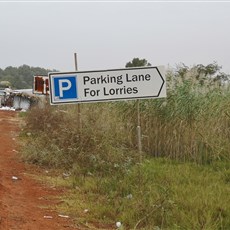
Soma to border
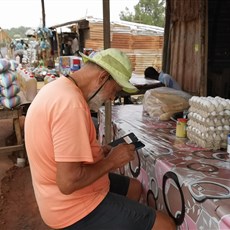
Soma to border - coffee break
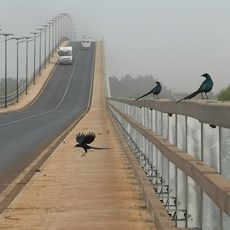
Soma to border
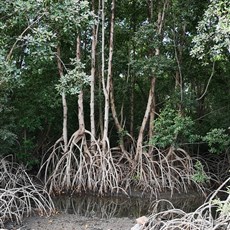
Soma to border
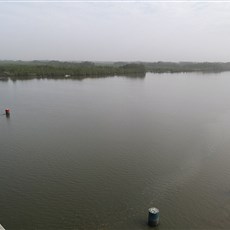
The River Gambia
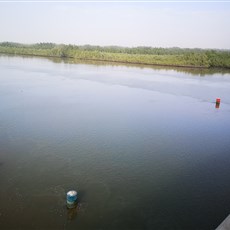
The River Gambia
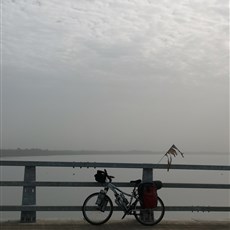
The River Gambia
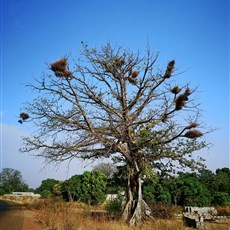
Soma to border